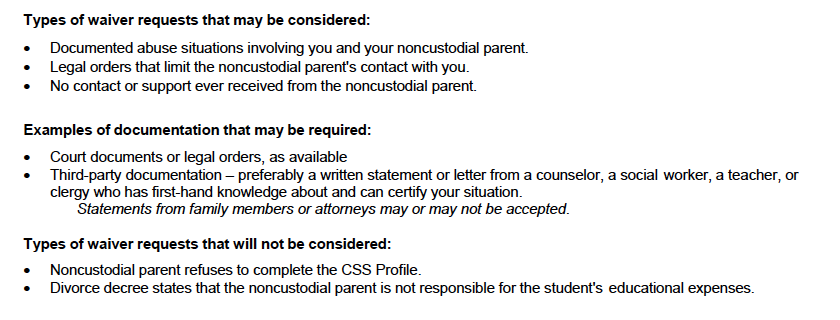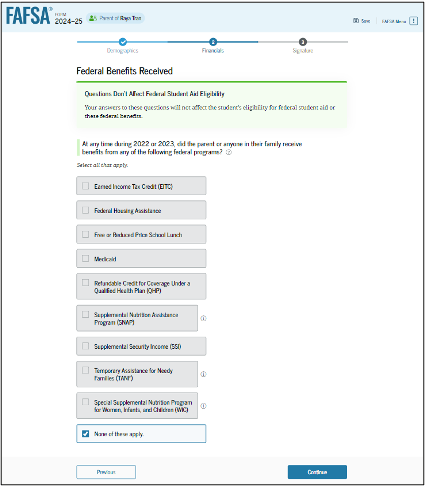什么是学生资助指数?
2026-27 年 FAFSA,或 联邦学生资助免费申请是2026-27学年申请基于需求的助学金的主要途径。学生和一位或多位家长提交家庭和财务信息。FAFSA会根据这些信息计算出一个家庭在特定年份可以支付的大学费用,即 学生资助指数(SAI).
一所大学的财政援助办公室使用 学生资助指数 下面的简单公式可以确定学生是否有资格获得基于需求的经济援助,考虑到学院的 出席费用.
出席费用
– 学生资助指数(SAI)
_____________________________
= 财务需求
一名学生的 财务需求 是他们的 合格 寻求大学援助。 然而,每所大学分配机构需求资金的政策决定了学生最终将获得的经济援助金额,这可能会或可能不会满足学生的计算需求 财务需求. 阅读更多
学生援助指数是如何计算的?
家庭规模、父母的婚姻状况、居住州以及四个主要财务投入决定了 2026-27 年学生援助指数。
- 家长2024年收入
- 申报日的父母资产
- 学生2024年收入
- 申报日的学生资产
一个重大变化是,大学学生人数将不再用于 SAI 计算公式。
1)父母收入
2026-27 年度 FAFSA 申请将依据 2024 年联邦纳税申报表计算所有父母收入,从而取消了未包含在联邦纳税申报表中的非税收入的申报。雇主赞助的退休计划(例如 401k、403b、养老金等)的税前缴款不再计入父母收入。
如果父母在2024年无需提交联邦纳税申报表,则SAI = -$1,500。此步骤已纳入本计算器。 阅读更多
2)母公司资产
2026-27 年 FAFSA 将以下资产计入父母可用于支付大学费用的净资产的一部分:
- 检查
- 储蓄/货币市场账户
- CD
- 经纪账户
- 529 或大学储蓄计划 仅有的 对于学生申请人
- 第二套房产的权益价值。
另外两个类别可算作母公司资产,用于计算 SAI。
- 已收到子女抚养费。
父母应在提交 FAFSA 申请表之前的日历年内将收到的所有子女抚养费报告为资产。 - 企业或农场的净值。
如果父母拥有一家雇佣超过100名全职员工的企业或农场,则其净资产需在FAFSA表格中申报。净资产等于企业或农场的价值减去该企业或农场的任何债务。如果父母只是部分所有者,则需申报其在总净资产中所占的百分比。
受保护的资产 是 不算数 在 FAFSA 上:
- 退休账户 – 401k、403b、IRA、养老金等……
- 人寿保险
- 主要住所
报告的母公司资产净值总额贡献率约为5%。
3)学生收入
2026-27 学年 FAFSA 为学生提供相当于 $11,770 美元的收入保障。因此,如果 2024 年学生收入不超过 $11,770 美元,则预计不会产生任何学生收入贡献。超过此金额的每一美元,贡献率为 50%。
4)学生资产
学生退休后持有的所有资产均需申报,包括支票账户、储蓄账户、定期存单和经纪账户。学生持有的529账户或大学储蓄计划始终作为母资产申报。学生资产的缴费率为每1美元20%。
2026-27 FAFSA 学生资助指数计算器
要计算您的学生援助指数,请使用家长和学生 2024 年纳税申报表中的数值以及家长和学生资产的当前价值。 注意:此计算器适用于受抚养学生。
这个计算器是如何开发出来的?
此计算器遵循教育部于 2025 年 8 月发布的 2026-27 学年学生资助指数更新公式。您可以下载公式表 这里.
负的 SAI 意味着什么?
学生资助指数现在可低至 -$1,500。确定学生的资格(就读成本 – SAI = 经济需求/资格),大学会将 SAI 设为 $0。不过,在评估针对高需求学生的大学课程时,大学可能会考虑使用负数 SAI。


